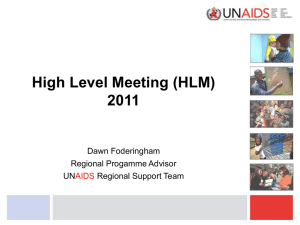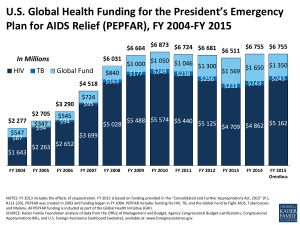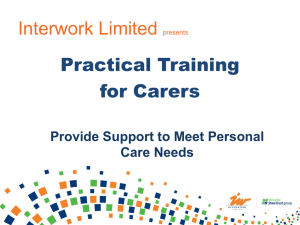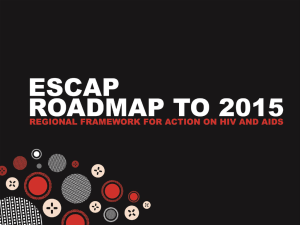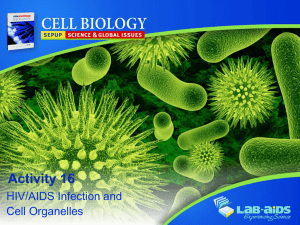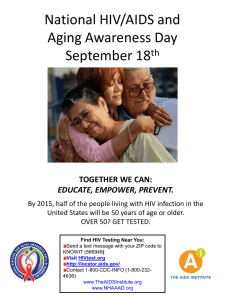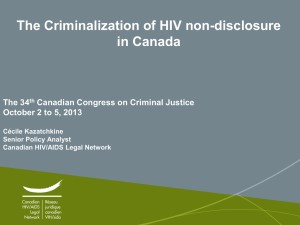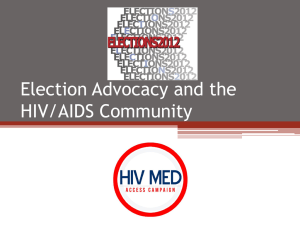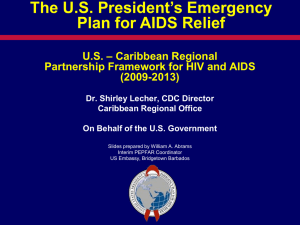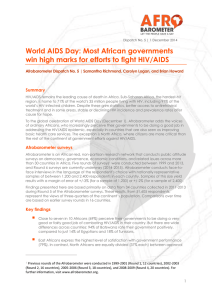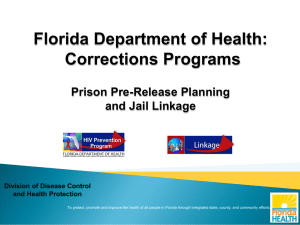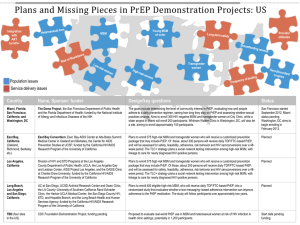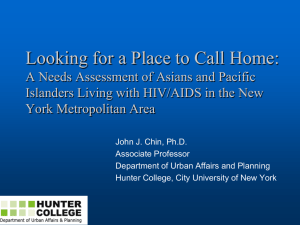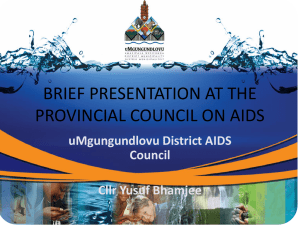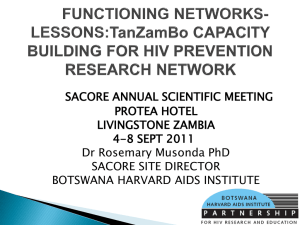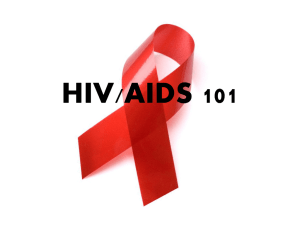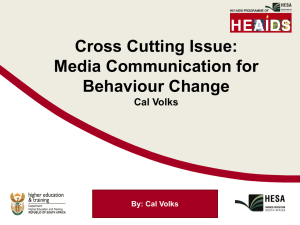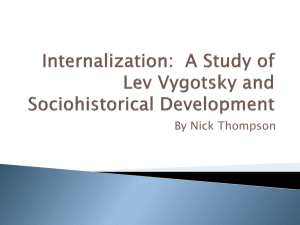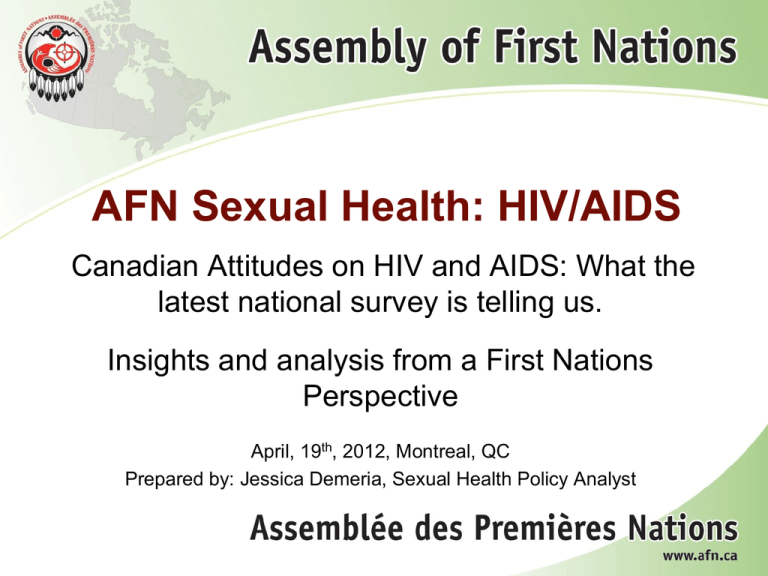
AFN Sexual Health: HIV/AIDS
Canadian Attitudes on HIV and AIDS: What the
latest national survey is telling us.
Insights and analysis from a First Nations
Perspective
April, 19th, 2012, Montreal, QC
Prepared by: Jessica Demeria, Sexual Health Policy Analyst
Who We Are
The Assembly of First Nations (AFN) is the national representative organization
of the First Nations in Canada. There are over 630 First Nations communities in
Canada. The AFN Secretariat, is designed to present the views of the various
First Nations through their leaders in areas such as:
• Aboriginal and Treaty Rights;
• Economic Development;
• Education, Languages and Literacy;
• Health and Social Development;
• Justice;
• Taxation;
• Land Claims;
• Housing; and,
• Environment.
2
Situating the Context of HIV/AIDS and
First Nations
•
Colonialism has dramatically contributed to the poor health and socioeconomic conditions in which First Nations currently reside, including
the incidence and prevalence of HIV/AIDS.
•
Colonialism is broadly defined as “the control or governing influence of
a nation over a dependent country, territory, or people; the system or
policy by which a nation maintains or advocates such control or
influence.” Colonialism works at both the formal and informal levels to
separate First Nations people from their territories, identities and ways
of being.
•
The ongoing consequences of colonialism must be understood when
working with First Nations.
3
Situating the Context of HIV/AIDS and
First Nations (cont’d)
• What the current numbers do illustrate is that there is a
significant over representation of First Nations, Inuit and Métis
(FN/I/M) among HIV and AIDS cases in Canada.
• These numbers show that First Nations are highly
overrepresented in the breakdown of identified AIDS cases,
such that, of 605 AIDS cases:
– 442 identified as First Nations;
– 22 as Inuit;
– 44 stated they were Métis; and,
– 97 were unspecified Aboriginal.
4
Situating the Context of HIV/AIDS and
First Nations (cont’d)
• FN/I/M represent only 3.8% of the total Canadian population
(2006 Census).
• The estimated prevalence of HIV/AIDS among FN/I/M in 2008
was 24% higher than the original estimation in 2005.
• In 2008, an estimated 4,300 to 6,100 Aboriginal people were
living with HIV/AIDS; 8.0% of all prevalent infections and 12.5 %
incidence for the same year.
• In 2008, FN/I/M in Canada had an estimated 3.6 times higher
HIV infection rate than non-Aboriginal people.
5
Situating the Context of HIV/AIDS and
First Nations (cont’d)
•
Aboriginal youth (15-29 years) represent 40.9% of all Canadian positive
tests for this age group (Public Health Agency, 2010).
•
HIV/AIDS has a significant impact on Aboriginal women in particular.
During 1998-2008, women represented 48.8% of all positive HIV test
reports among Aboriginal people, as compared with 20.6% of reports
among those of other ethnicities.
•
Among Aboriginal Canadians, the estimated proportion of new HIV
infections in 2008 attributed to the IDU exposure category (66%) was
much higher than among all Canadians (17%).
•
It becomes quite apparent that a distinct and unique strategy is
needed to address these numbers.
6
Testing
• In the National HIV/AIDS Survey, the main reason for testing
was through blood donation but there is no ethnic data available
to see if the same holds true for First Nations.
• There is some limited data available surrounding First Nations
youth and attitudes towards testing. The study “AIDS is
Something Scary: Canadian Aboriginal Youth and Testing” (Mill,
Wong, Archibald et. Al, 2011) provides some insight to the
barriers that youth face.
• 413 FN/I/M youth from all ten provinces and one territory
participated in the mixed method study.
• Just over 50% of the youth that completed the survey stated that
they had been tested for HIV, while 89.2% who were
interviewed had been tested at some point (Mill, 2011).
7
Testing
• Some of the reasons for testing:
–
–
–
–
–
–
having sex without a condom (43.6%);
being pregnant or thinking they were pregnant (35.4%);
part of regular testing (28.9%);
feeling like they were at risk (27.5%);
being in a new relationship (23.7%); and,
part of the sexually transmitted infections (STI) screening (20.9%).
• Within the larger cohort of FN/I/M, the demographics of the
group with the highest testing rates were:
–
–
–
–
–
First Nations older youth;
lived outside of a First Nations community;
received some type of social assistance;
had a history of STIs; and,
for females, had a history of pregnancy (ibid).
8
Testing
• Zin (pseudonym), a First Nations youth, stated, “It’s probably the
worst thing you could ever hear, depending on whether you care
or not…I’m sure it would be like the end of the world, like a wall
could come crashing down”.
• Other factors identified that limited youths decision to get tested
included:
– the fear of discrimination 13.3%;
– fear of people finding out 10.8%; and,
– that they felt “nothing could be done about it” 10.8%.
• Rates of HIV infections between 1998 and 2006 for FN/I/M
comprised 1/3 of new infections in those under the age of the 30
compared to 21% of non-Aboriginal cases it is clear that we
need to focus on preventing new infections within our youth.
9
PHAC, 2010
10
PHAC, 2010
11
Conclusions
• While it has become clear that HIV testing and services need to
be accessible and appropriate for youth, there is a significant
lack of STI “youth-friendly” services (Shoveller, 2009).
• What this translates into is the need for relevant, culturally
safe testing programs for STI’s and HIV prevention
programs targeted at the most vulnerable populations
including youth.
• Prevention and education programs need to be tailored to
facilitate reductions in future infections.
12
Next Steps
• The AFN will continue to increase awareness and
decrease stigma surrounding HIV/AIDS through the
broader spectrum of sexual health.
• The AFN will continue to engage in strategic
partnerships and networks to foster knowledge
exchange to work towards alleviating the higher
HIV/AIDS rates in First Nations communities.
• First Nations need to work together to address these
rates and ensure that the prevention and education
strategies are tailored to meet the needs of those
most at risk and marginalized within the Canadian
system.
13
Next Steps
• The AFN will continue to try and increase awareness
of the current status of First Nations and HIV/AIDS
rates on an international level.
• The AFN will continue to be respectful and
responsive to the needs of First Nations living with
HIV/AIDS in Canada.
• The AFN will provide support to Aboriginal AIDS
Service Organizations (AASO’s) and continue to work
in partnership with AIDS Service Organizations
(ASO’s).
14
For more information please contact:
Jessica Demeria, Policy and Research Analyst
jdemeria@afn.ca or 1-866-869-6789 ext. 248
www.afn.ca
15


